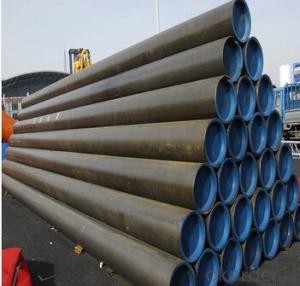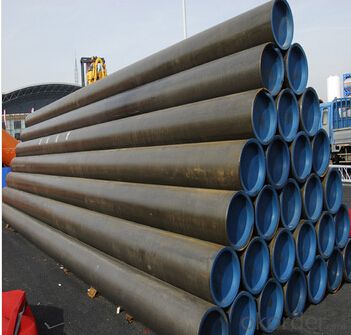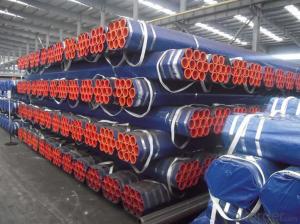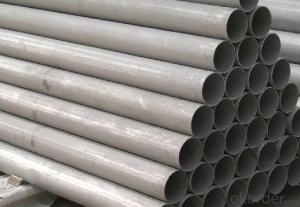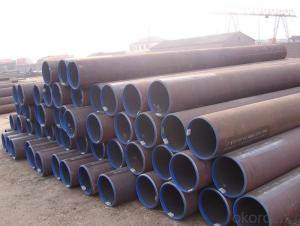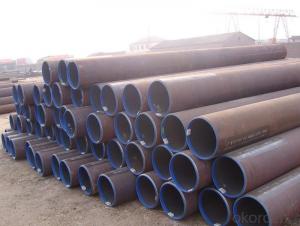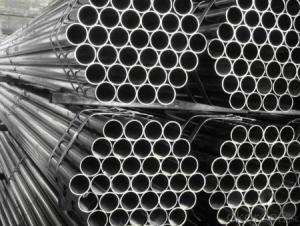seamless steel pipe for gas, water or oil industries
- Loading Port:
- Shanghai
- Payment Terms:
- TT OR LC
- Min Order Qty:
- 25 m.t.
- Supply Capability:
- 5000 m.t./month
OKorder Service Pledge
OKorder Financial Service
You Might Also Like
Specifications
1.ASTM A106/A53 GR.B
2.Outer diameter:10.3-194.4mm
3.Wall thickness:6.5-59mm
4.Cer:ISO9001:2008,API
Seamless steel pipe
(1) Standard: GB8163, ASTM A106/A53/API 5L
(2) Material: 10#, 20#, 16Mn, A106Gr.A/B/C,
(3)Specification: O.D: 21.3mm-711.2 mm
(4) W.T: 2.11mm-59.54mm
Technical Parameters of Seamless Steel Pipe
A53: Chemical components and mechanical property
Stan- dard | Trade mark | Chemical components | Mechanical property | ||||||||||
| C | Si | Mn | P,S | Cu | Ni | Mo | Cr | V | Tensile Strength | Yield Strength | Elongation | ||
ASTM A53 | A | ≤0.25 | / | ≤0.92 | ≤0.05 | ≤0.06 | ≤0.40 | ≤0.15 | ≤0.40 | ≤0.08 | ≥330 | ≥205 | ≥29.5 |
| B | ≤0.30 | / | ≤1.2 | ≤0.05 | ≤0.06 | ≤0.40 | ≤0.15 | ≤0.40 | ≤0.08 | ≥415 | ≥240 | ≥29.5 | |
A106: Chemical components and mechanical property
| Stan-dard | Trade mark | Chemical components | Mechanical property | ||||||||||
| C | Si | Mn | P,S | Cu | Ni | Mo | Cr | V | Tensile Strength | Yield Strength | Elongation | ||
ASTM A106 | B | ≤0.30 | ≥0.10 | 0.29-1.06 | ≤0.035 | ≤0.40 | ≤0.40 | ≤0.15 | ≤0.40 | ≤0.08 | ≥415 | ≥240 | ≥30 |
| C | ≤0.35 | ≥0.10 | 0.29-1.06 | ≤0.035 | ≤0.40 | ≤0.40 | ≤0.15 | ≤0.40 | ≤0.08 | ≥485 | ≥275 | ≥30 | |
PSL 1: Chemical components and mechanical property
| Class and Sort | Chemical components | Mechanical property | |||||||
| C(Max) | Mn(Max) | P(Max) | S(Max) | Tensile Strength(Min) | Yield Strength(Min) | ||||
| A25 | CL I | 0.21 | 0.60 | 0.030 | 0.030 | 45.000 | 310 | 25.000 | 172 |
| CL II | 0.21 | 0.60 | 0.030 | 0.030 | |||||
| A | 0.22 | 0.90 | 0.030 | 0.030 | 48.000 | 331 | 30.000 | 207 | |
| B | 0.28 | 1.20 | 0.030 | 0.030 | 60.000 | 414 | 35.000 | 241 | |
| X42 | 0.28 | 1.30 | 0.030 | 0.030 | 60.000 | 414 | 42.000 | 290 | |
| X46 | 0.28 | 1.40 | 0.030 | 0.030 | 63.000 | 434 | 46.000 | 317 | |
| X52 | 0.28 | 1.40 | 0.030 | 0.030 | 66.000 | 455 | 52.000 | 359 | |
| X56 | 0.28 | 1.40 | 0.030 | 0.030 | 71.000 | 490 | 56.000 | 386 | |
| X60 | 0.28 | 1.40 | 0.030 | 0.030 | 75.000 | 517 | 60.000 | 414 | |
| X65 | 0.28 | 1.40 | 0.030 | 0.030 | 77.000 | 531 | 65.000 | 448 | |
| X70 | 0.28 | 1.40 | 0.030 | 0.030 | 82.000 | 565 | 70.000 | 483 | |
Our catalog of Seamless steel pipe
| item | material | standard | specification (OD*WT)mm | usage |
| alloy pipe | Cr5Mo. 15CrMo 13CrMo44 12Cr1MoV P22 T91,P91,P9, T9 Wb36 | GB5310-95 GB9948-88 ASTMA335/A335M ASTMA213/213M DIN17175-79 JISG3467-88 JISG3458-88 | 16-824*2-100 | The seamless steal pipes features resistance to high pressure, high/low temperature and corrosion and is used in the industries of petroleum, chemical engineering and. Electric power as well as boiler |
High-pressure boiler pipe | 20G,A106, ST 45 | GB5310-95 ASTM A 106-99 DIN17175-79 | 14-630*2-80 | Temperature-resistant seamless steel pipe far high-pressure boiler |
Seamless pipes for petroleum | 20, 12CrMo, 15CrMo | GB9948-88 | 10-530*1.5-36 | Boiler pipes for refinery, heat-exchanging pipes, seamless steel pipes for pipeline |
High-pressure Seamless pipes for fertilizer making equipment | 20, 16Mn, Q345 | GB6479-2000 | 18-530*3-40 | Fertilizer making equipment and pipe line |
Low and medium- pressure boiled pipe | 10,20 | GB3087-1999 | 10-530*2-40 | Over-heat pipe for low and medium pressure boiler, boiling water pipe, locomotive smoke pipe(big and small) |
| Fluid pipe | 20, Q345 | GB/T8163-1999 | 8-630*1.0-40 | Fluid feeding |
| Structural pipe | 20, Q345 10, 20,35,45, 16Mn,Q345B | GB/T8162-1999 | 6-1020*1.5-100 | For common structure |
| Line pipe | Gr.B | API | 60-630*1.5-40 | Carrying gas, water or oil in the industries of petroleum and natural gas |
Hydraulic prop pipe | 27SiMn | GB/T17396-1998 | 70-377*9-40 | Hydraulic support and prop |
- Q: Are steel pipes affected by UV rays?
- Yes, steel pipes can be affected by UV rays. Prolonged exposure to UV radiation can lead to the degradation of the protective coatings on steel pipes, causing them to corrode and weaken over time. It is important to implement proper protective measures, such as applying UV-resistant coatings or using protective covers, to mitigate the impact of UV rays on steel pipes.
- Q: What is the average lifespan of a steel pipe?
- The average lifespan of a steel pipe can vary depending on various factors such as the quality of the steel, the environment it is exposed to, and the maintenance practices followed. However, on average, a well-maintained steel pipe can last anywhere between 20 to 100 years.
- Q: Can steel pipes be used for transporting drinking water?
- Yes, steel pipes can be used for transporting drinking water. Steel pipes are commonly used in water distribution systems and have been used for many years. They are known for their durability, strength, and resistance to corrosion. However, it is important to ensure that the steel pipes used for transporting drinking water are properly coated or lined to prevent any potential contamination from the metal. Additionally, regular inspections and maintenance should be carried out to ensure the integrity of the pipes and to prevent any leaks or breaks that could compromise the quality of the water.
- Q: Can steel pipes be used for mining applications?
- Yes, steel pipes can be used for mining applications. Steel pipes are known for their strength, durability, and resistance to extreme conditions, making them suitable for various mining activities such as transporting water, air, or chemicals, as well as for structural support and ventilation systems in mines.
- Q: How are steel pipes used in the manufacturing of boilers?
- Due to their strength, durability, and heat-resistant properties, steel pipes are essential components in the manufacturing of boilers. Boilers are utilized in various industrial and commercial applications to generate steam or heat water. The construction of boiler tubes is where steel pipes are primarily employed, as they function as the main heat transfer medium. Considering the high temperatures and pressure that these tubes are subjected to, it is crucial to use a material that can withstand such extreme conditions. Steel, with its excellent mechanical properties and corrosion resistance, is the ideal choice for this purpose. To create the boiler tubes, the manufacturing process involves shaping and sizing the steel pipes accordingly. These tubes are then connected to form a network of channels through which hot gases or water can flow. Depending on the boiler design requirements, the steel pipes utilized in this process are often seamless or welded. For the safety and efficiency of the system, the steel pipes used in boilers must meet stringent quality standards. They are subjected to tests to ensure their ability to withstand high pressure, temperature, and corrosion. Furthermore, inspections and tests such as ultrasonic testing and radiographic examination are conducted to identify any defects or flaws that might compromise the performance of the boiler. In conclusion, steel pipes play a critical role in the manufacturing of boilers by serving as the primary material for boiler tubes. Their strength, durability, and heat-resistant properties make them suitable for enduring high temperatures and pressure. These pipes undergo rigorous testing to guarantee their quality and reliability in creating efficient and safe boiler systems.
- Q: How are steel pipes used in structural applications?
- Steel pipes are commonly used in structural applications due to their high strength and durability. They are used for various purposes such as supporting structures, transferring loads, and providing stability. Steel pipes can be used as columns, beams, or trusses in buildings, bridges, and other structures. They are also used for underground water and gas pipelines, as well as in industrial and manufacturing facilities. Overall, steel pipes play a crucial role in providing stability and strength to structural applications.
- Q: What are the common methods for cleaning the inner surface of steel pipes?
- There are several common methods for cleaning the inner surface of steel pipes. Some of the most widely used methods include: 1. Mechanical Cleaning: This method involves the use of mechanical tools such as wire brushes, scrapers, or abrasive pads to physically remove debris, rust, or scale from the inner surface of the steel pipe. This method is effective for removing loose or loosely adhered contaminants. 2. Chemical Cleaning: Chemical cleaning involves the use of acidic or alkaline solutions to dissolve or loosen stubborn deposits, rust, or scale on the inner surface of steel pipes. The solution is usually circulated through the pipe for a specific period of time, allowing the chemical to react and break down the contaminants. This method is often used when mechanical cleaning is not sufficient. 3. High-Pressure Water Jetting: In this method, high-pressure water is directed through a nozzle into the steel pipe, effectively removing debris, rust, or scale from the inner surface. The force of the water jet helps dislodge and flush out the contaminants. This method is particularly efficient for cleaning pipes with complex geometries or hard-to-reach areas. 4. Shot Blasting: Shot blasting involves the use of high-speed abrasive particles propelled against the inner surface of the steel pipe to remove rust, scale, or other contaminants. This method is commonly used for larger pipes or pipes with heavy deposits. It provides a thorough and uniform cleaning by removing the surface layer of the steel along with the contaminants. 5. Ultrasonic Cleaning: Ultrasonic cleaning uses high-frequency sound waves to create microscopic bubbles in a cleaning solution. These bubbles implode upon contact with the inner surface of the steel pipe, effectively loosening and removing contaminants. This method is particularly effective for cleaning small-diameter pipes or pipes with intricate details. It is important to note that the selection of the cleaning method depends on various factors such as the type and extent of contamination, pipe size and geometry, and the desired level of cleanliness. Additionally, proper safety measures should always be taken when performing any cleaning method to ensure the protection of workers and the integrity of the steel pipes.
- Q: Where is the difference between seamless steel pipe and welded pipe?
- Seamless steel tube is formed during rolling. Welded steel pipes need to be welded after coiling, and spiral welding and direct welding are generally used. Seamless performance is better, of course, the price is higher.
- Q: How do you prevent steel pipes from freezing?
- To prevent steel pipes from freezing, there are several measures you can take: 1. Insulate the pipes: Use foam insulation sleeves or wrap the pipes with insulation tape. This will help maintain the temperature of the pipes and prevent them from freezing. 2. Seal any gaps or cracks: Inspect the area around the pipes and seal any gaps or cracks with caulk or expanding foam. This will prevent cold air from entering and freezing the pipes. 3. Install heat cables: Heat cables can be wrapped around the steel pipes to provide a steady source of heat. These cables can be controlled by a thermostat, ensuring that the pipes stay above freezing temperature. 4. Keep the temperature above freezing: In areas where extreme cold weather is common, it is advisable to keep the indoor temperature above freezing, even if the property is vacant. This will help maintain a suitable temperature for the pipes and prevent freezing. 5. Open cabinets and faucets: In particularly cold weather, open cabinet doors in kitchens and bathrooms to allow warm air to circulate around the pipes. Additionally, allowing faucets to drip slightly can also prevent freezing by keeping water flowing. 6. Drain the pipes: If you are leaving your property unoccupied during freezing weather, it is recommended to drain the pipes completely. This can be done by shutting off the main water supply and opening all faucets until no water remains. This minimizes the risk of freezing and potential damage. Remember, prevention is crucial in protecting steel pipes from freezing. By implementing these measures, you can significantly reduce the risk of frozen pipes and potential costly repairs.
- Q: Can steel pipes be used for drainage systems?
- Yes, steel pipes can be used for drainage systems. Steel pipes are strong, durable, and resistant to corrosion, making them suitable for carrying and directing wastewater. Additionally, their smooth interior surface allows for efficient water flow, making them a reliable choice for drainage applications.
Send your message to us
seamless steel pipe for gas, water or oil industries
- Loading Port:
- Shanghai
- Payment Terms:
- TT OR LC
- Min Order Qty:
- 25 m.t.
- Supply Capability:
- 5000 m.t./month
OKorder Service Pledge
OKorder Financial Service
Similar products
Hot products
Hot Searches
Related keywords
